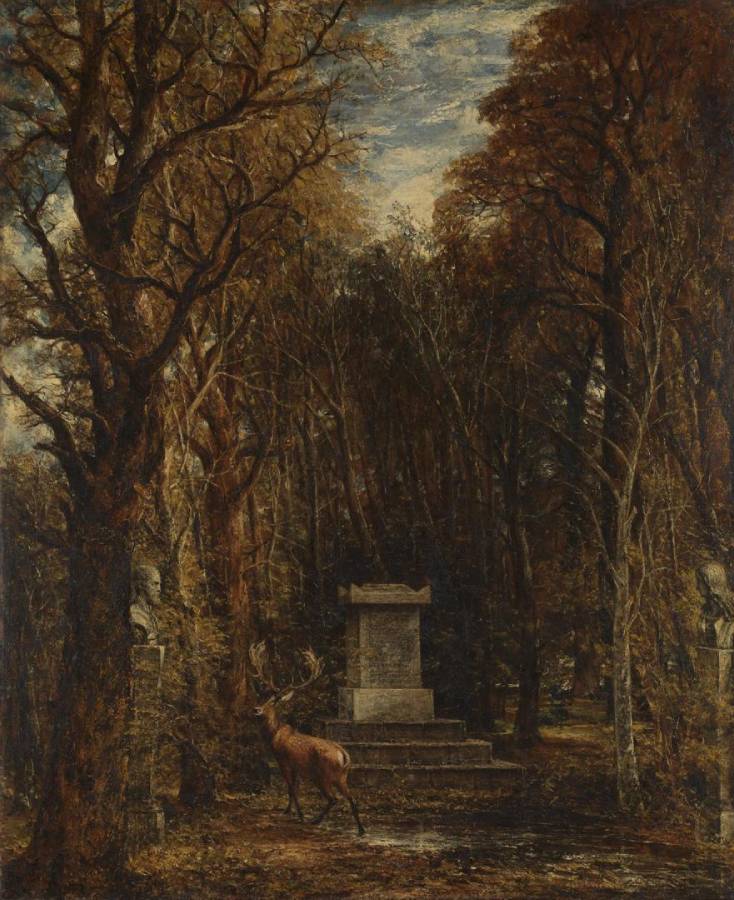Constable, John (1776-1837)
Cenotaph to the Memory of Sir Joshua Reynolds
1833–1836
Oil on canvas, 132 × 108.5 cm
National Gallery, London
Cenotaph to the Memory of Sir Joshua Reynolds, erected in the grounds of Coleorton Hall, Leicestershire by the late Sir George Beaumont, Bt.
This painting is based on a pencil drawing in the Victoria and Albert Museum, London. Dated 28 November 1823, it was made on the last day of Constable’s six-week stay at the home of Sir George Beaumont (1753–1827) and his family at Coleorton Hall in Leicestershire. Beaumont played a crucial part in the creation of the National Gallery and made the first bequest of paintings in 1825.
Beaumont was a friend and great admirer of the painter Sir Joshua Reynolds. In 1812, 20 years after Reynolds’s death, Beaumont erected a stone ‘urn’ dedicated to his memory in the grounds of Coleorton Hall. He planned to redesign the gardens to include other memorials dedicated to his friends and the people he revered. The poet William Wordsworth spent about a month at Coleorton in the summer of 1810 composing inscriptions for the memorials.
The memorial to Reynolds was to be situated at the end of an avenue of lime trees, recently planted near the Hall. As Constable shows in his painting, busts of the great artists of the Italian Renaissance, Michelangelo and Raphael, were placed near the start of the lime avenue, each mounted on a tall tapering block of stone. In reality, they were not as close to Reynolds’s memorial as Constable paints them.
Constable was staying with the Beaumonts to make copies of their landscape paintings by the seventeenth-century French painter, Claude. He spent some of his time sketching outdoors. In a letter to his friend, the Reverend John Fisher, Constable wrote: ‘In the dark recesses of these gardens, and at the end of one of the walks, I saw an urn […] of Sir Joshua Reynolds – & under it some beautifull verses, by Wordsworth.’ He made a pencil and grey wash drawing of it in his sketchbook.
Ten years later, Constable began to turn the pencil drawing made on the spot at Coleorton into the oil painting, which he was to entitle Cenotaph to the Memory of Sir Joshua Reynolds. He appears to have worked on the painting in early 1833. Three years later, Constable returned to the canvas, aiming to finish it in time for the Royal Academy exhibition of 1836.
Constable was unsure how best to represent the inscription on the memorial; a painter and fellow member of the Royal Academy, C.R. Leslie (1794–1859), advised him to make only the words ‘REYNOLDS’ legible and just to suggest the other lines. Constable’s introduction of a stag in the picture gives a sense of the wildness of the setting, but a false sense of the memorial’s size. In reality the stag would have been taller than the monument, but in the picture it is half the size.
The picture received a mixed reception at the Royal Academy exhibition. The Morning Chronicle’s review was one of the most positive: ‘The peculiar manner in which Mr Constable’s pictures are painted makes them appear singular at first, but by choosing a proper distance for observing them, by degrees the effect seems to grow on us until we are astonished that we did not like them better before.’
This was the last painting that Constable exhibited at the Royal Academy. It did not find a buyer. (NG)
See also:
• Reynolds, Joshua (1723-1792) | Wordsworth, William (1770-1850)
